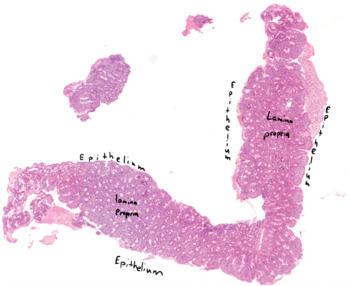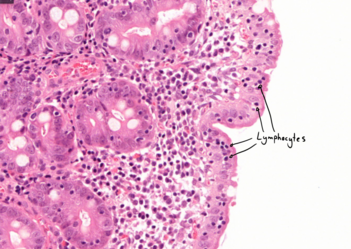3. Coeliac disease – total villus atrophy (Marsh 3c): Difference between revisions
(Created page with "'''Staining''': HE '''Organ''': Duodenum '''Description''': It’s kind of confusing but both “sides” of the preparation shows the mucosa. This is due to the fixation process. Only the epithelium mucosae and lamina propria can be seen, no other layers. No villi are visible. There is crypt hyperplasia as the number of crypts is increased compared to normal. Lymphocytes are seen in the epithelium mucosae, showing intraepithelial lymphocytosis. '''Diagnosis''': Co...") |
No edit summary |
||
| (2 intermediate revisions by the same user not shown) | |||
| Line 1: | Line 1: | ||
'''Staining''': HE | [[File:Coeliac disease - overview.png|thumb|Overview. In most of the epithelium there is complete villous atrophh, as no villi are visible – the mucosa is almost completely flat. On the epithelium on the right side you can see some very atrophic villi (see the comments). Even with low magnification can we see that the number of crypts is high compared to normal.|350x350px]]'''Staining''': HE | ||
'''Organ''': Duodenum | '''Organ''': Duodenum | ||
'''Description''': | '''Description''': It’s kind of confusing but both “sides” of the preparation shows the mucosa. This is due to the fixation process. | ||
Only the epithelium mucosae and lamina propria can be seen, no other layers. No villi are visible. There is crypt hyperplasia as the number of crypts is increased compared to normal. Lymphocytes are seen in the epithelium mucosae, showing intraepithelial lymphocytosis. | |||
Only the epithelium mucosae and lamina propria can be seen, no other layers. | |||
No villi are visible. There is crypt hyperplasia as the number of crypts is increased compared to normal. Lymphocytes are seen in the epithelium mucosae, showing intraepithelial lymphocytosis. | |||
'''Diagnosis''': Coeliac disease | '''Diagnosis''': Coeliac disease | ||
''' | '''Risk factors''': HLA-DQ2 or HLA-DQ8 | ||
Coeliac disease, or gluten-sensitive enteropathy is diagnosed based on a biopsy from the duodenum during a gastroscopy. | '''Theory''':[[File:Coeliac disease - intraepithelial lymphocytosis.png|thumb|Intraepithelial lymphocytosis|351x351px]]Coeliac disease, or gluten-sensitive enteropathy is diagnosed based on a biopsy from the duodenum during a gastroscopy. | ||
We use the Marsh classification to determine the severity of the coeliac disease. There are three histological alterations that are seen in coeliac disease: | We use the Marsh classification to determine the severity of the coeliac disease. There are three histological alterations that are seen in coeliac disease: | ||
| Line 27: | Line 19: | ||
# Villous atrophy (to which degree the villi are destroyed) | # Villous atrophy (to which degree the villi are destroyed) | ||
The Marsh classification goes from 1 to 3 and | The Marsh classification goes from 1 to 3 and works like this: | ||
* Marsh 1 – Only intraepithelial lymphocytosis is seen | * Marsh 1 – Only intraepithelial lymphocytosis is seen | ||
| Line 33: | Line 25: | ||
* Marsh 3 – Intraepithelial lymphocytosis, crypt hyperplasia and villous atrophy are seen | * Marsh 3 – Intraepithelial lymphocytosis, crypt hyperplasia and villous atrophy are seen | ||
In addition to this is Marsh 3 divided into a, b and c subtypes depending on the severity of the villous atrophy, where c is total villous atrophy. In this slide are areas where there are no evidence of villi, so it’s Marsh 3c. | In addition to this is Marsh 3 divided into a, b and c subtypes depending on the severity of the villous atrophy, where c is total villous atrophy. In this slide are areas where there are no evidence of villi, so it’s Marsh 3c. ''The Marsh classification originally had a Marsh 4 as well, which included hypoplasia of the small bowel architecture, but the original classification has been revised to only go from 1 – 3.'' The number of intestinal crypts (of Lieberkühn) is normally low in the duodenum, however here can we see that crypts are plenty. | ||
''The Marsh classification originally had a Marsh 4 as well, which included hypoplasia of the small bowel architecture, but the original classification has been revised to only go from 1 – 3.'' | |||
The number of intestinal crypts (of Lieberkühn) is normally low in the duodenum, however here can we see that crypts are plenty. | |||
[[Category:Pathology 2 - Histopathology slides]] | [[Category:Pathology 2 - Histopathology slides]] | ||
Latest revision as of 14:12, 7 July 2024

Staining: HE
Organ: Duodenum
Description: It’s kind of confusing but both “sides” of the preparation shows the mucosa. This is due to the fixation process.
Only the epithelium mucosae and lamina propria can be seen, no other layers. No villi are visible. There is crypt hyperplasia as the number of crypts is increased compared to normal. Lymphocytes are seen in the epithelium mucosae, showing intraepithelial lymphocytosis.
Diagnosis: Coeliac disease
Risk factors: HLA-DQ2 or HLA-DQ8
Theory:

Coeliac disease, or gluten-sensitive enteropathy is diagnosed based on a biopsy from the duodenum during a gastroscopy.
We use the Marsh classification to determine the severity of the coeliac disease. There are three histological alterations that are seen in coeliac disease:
- Intraepithelial lymphocytosis (presence of lymphocytes among the epithelium)
- Crypt hyperplasia (increased number of crypts)
- Villous atrophy (to which degree the villi are destroyed)
The Marsh classification goes from 1 to 3 and works like this:
- Marsh 1 – Only intraepithelial lymphocytosis is seen
- Marsh 2 – Intraepithelial lymphocytosis and crypt hyperplasia are seen
- Marsh 3 – Intraepithelial lymphocytosis, crypt hyperplasia and villous atrophy are seen
In addition to this is Marsh 3 divided into a, b and c subtypes depending on the severity of the villous atrophy, where c is total villous atrophy. In this slide are areas where there are no evidence of villi, so it’s Marsh 3c. The Marsh classification originally had a Marsh 4 as well, which included hypoplasia of the small bowel architecture, but the original classification has been revised to only go from 1 – 3. The number of intestinal crypts (of Lieberkühn) is normally low in the duodenum, however here can we see that crypts are plenty.
